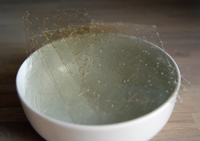
Photo from wikipedia
Supramolecular hydrogels based on inclusion complexation between cyclodextrins (CDs) and polymers have attracted much interest due to their potential for biomedical applications. It is also attractive to incorporate stimuli-responsive properties… Click to show full abstract
Supramolecular hydrogels based on inclusion complexation between cyclodextrins (CDs) and polymers have attracted much interest due to their potential for biomedical applications. It is also attractive to incorporate stimuli-responsive properties into the system to create "smart" hydrogels. Herein, a poly(N-isopropylacrylamide) (PNIPAAm) star polymer with a β-CD core and an adamantyl-terminated poly(ethylene glycol) (Ad-PEG) polymer were synthesized. They self-assembled into a thermoresponsive pseudo-block copolymer through a host-guest complexation, and formed supramolecular micelles with the change of environment temperature. Subsequently, an injectable polypseudorotaxane-based supramolecular hydrogel was formed between α-CD and the PEG chains of the pseudo-block copolymer. The hydrogel had a unique network structure involving two types of supramolecular self-assemblies between cyclodextrins and polymers, i.e., the host-guest complexation between β-CD units and adamantyl groups, and the polypseudorotaxane formation between α-CD and PEG chains. We hypothesize that the dual supramolecular hydrogel formed at room temperature may be enhanced by increasing the temperature over the lower critical solution temperature (LCST) of PNIPAAm, due to the hydrophobic interactions of PNIPAAm segments. Further, if the hydrogel is applied for sustained delivery of hydrophobic drugs, the copolymer dissolved from the hydrogel could micellize and continue to serve as micellar drug carriers with the drug encapsulated in the hydrophobic core. Rheological tests revealed that the hydrophobic interactions of the PNIPAAm segments could significantly enhance the strength of the hydrogel when temperature increased from 25 to 37 °C. As compared to hydrogels formed by α-CD and PEG only, the sustained release property of this thermoresponsive hydrogel for an anticancer drug, doxorubicin (DOX), was improved at 37 °C. The hydrogel dissolved slowly and released the pseudo-block copolymer in the forms of micelles that continued to serve as drug carriers with DOX encapsulated in the hydrophobic core, achieving a better cellular uptake and anticancer effect than free DOX controls even in multidrug resistant cancer cells. According to these findings, the dual supramolecular hydrogel developed in this work with remarkable thermoresponsive properties might have potential for sustained anticancer drug delivery with enhanced therapeutic effect in multidrug resistant cancer cells.
Journal Title: Biomacromolecules
Year Published: 2020
Link to full text (if available)
Share on Social Media: Sign Up to like & get
recommendations!